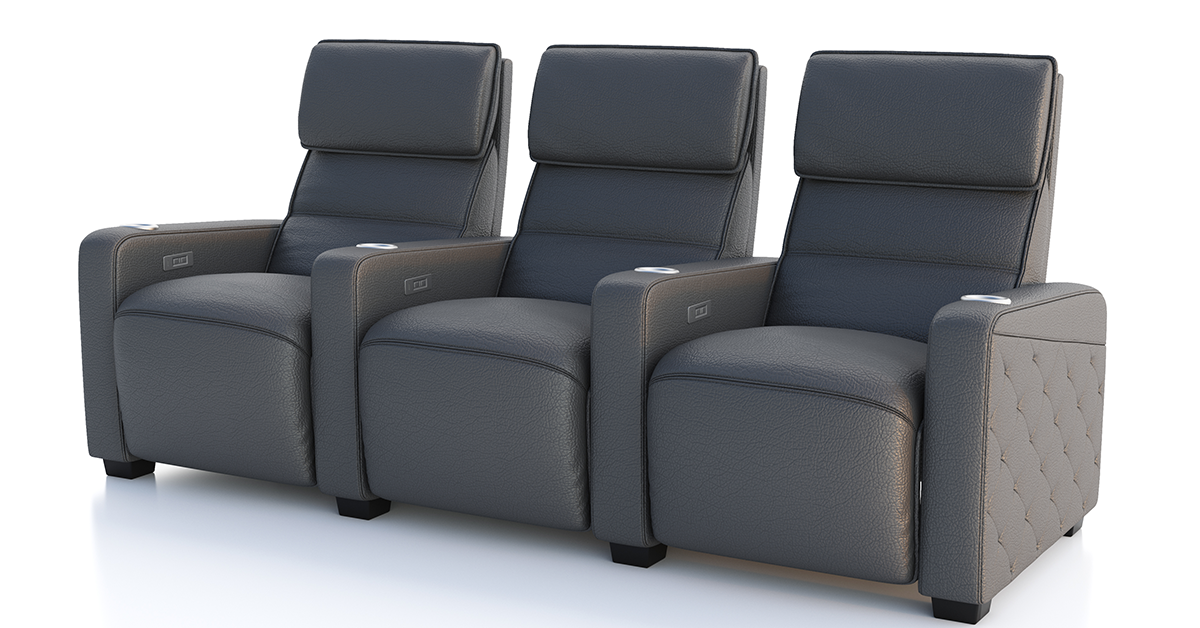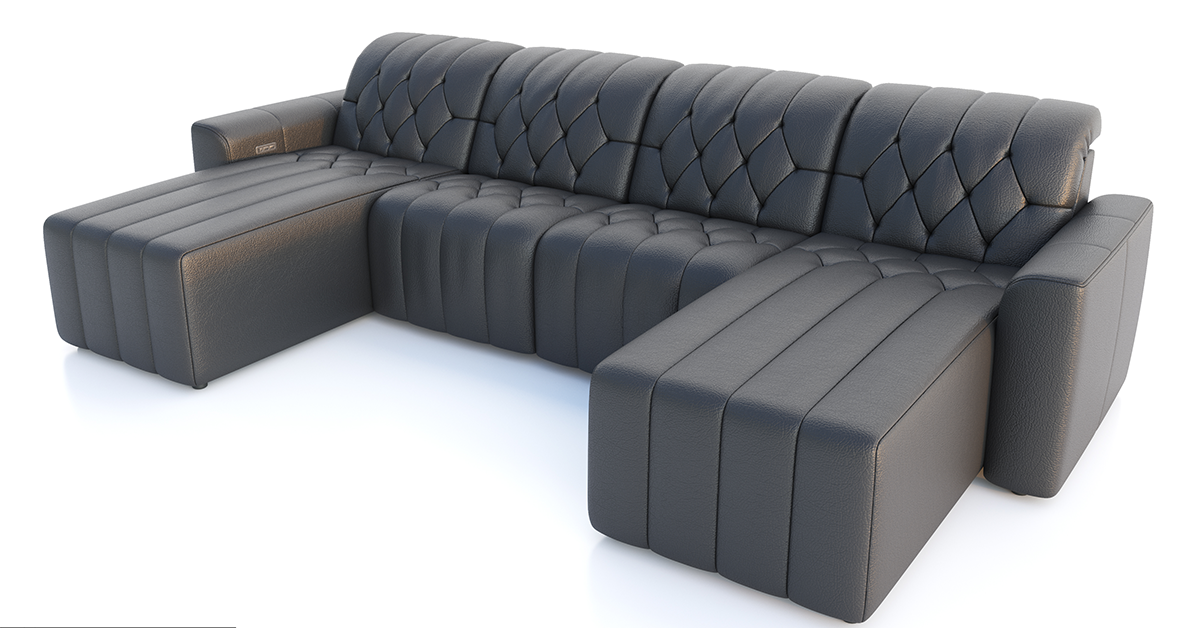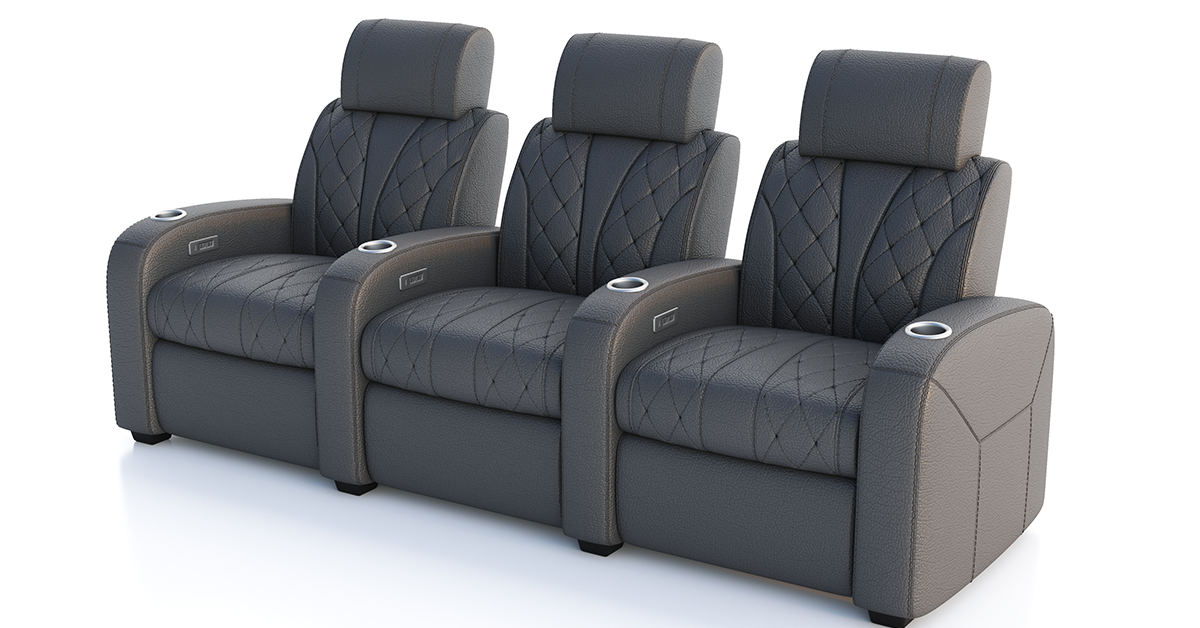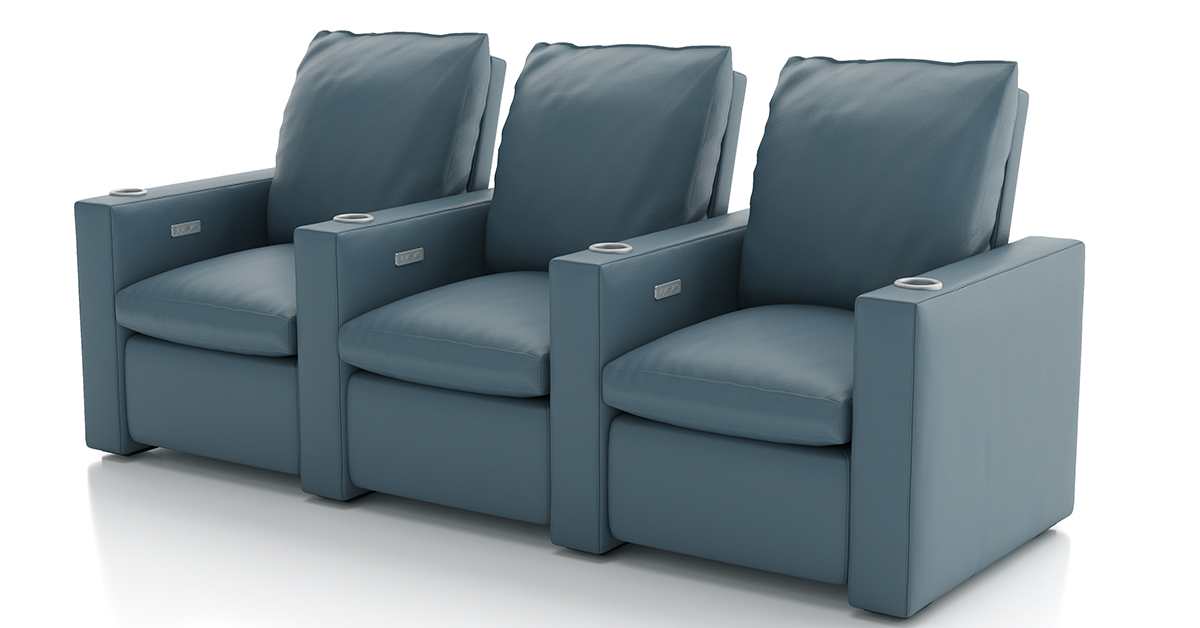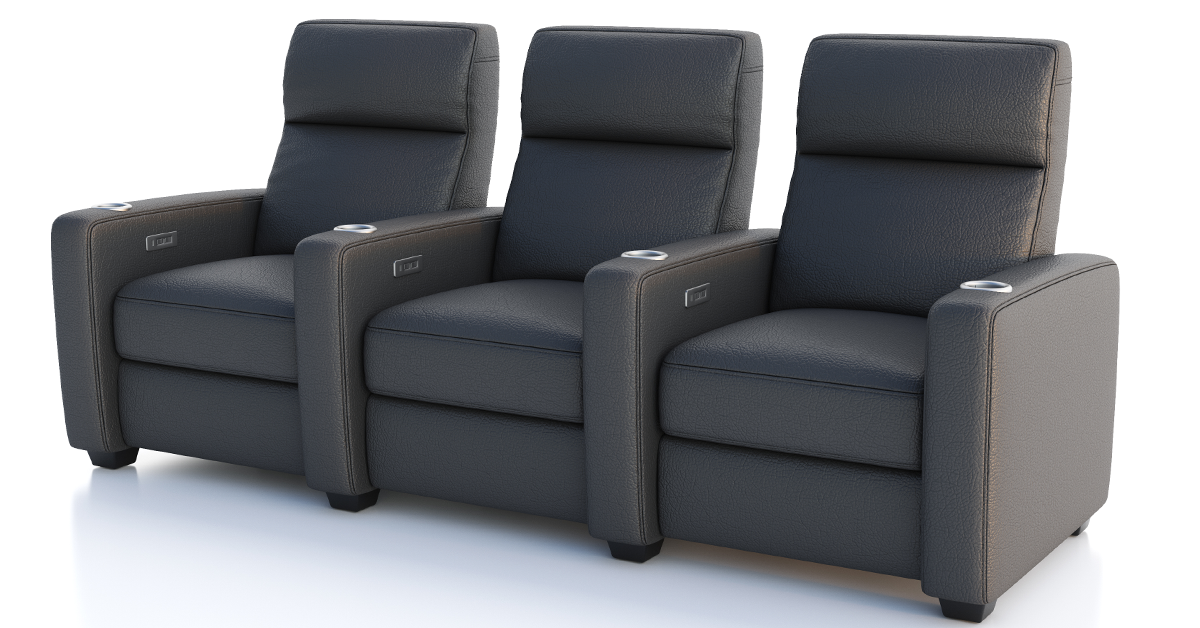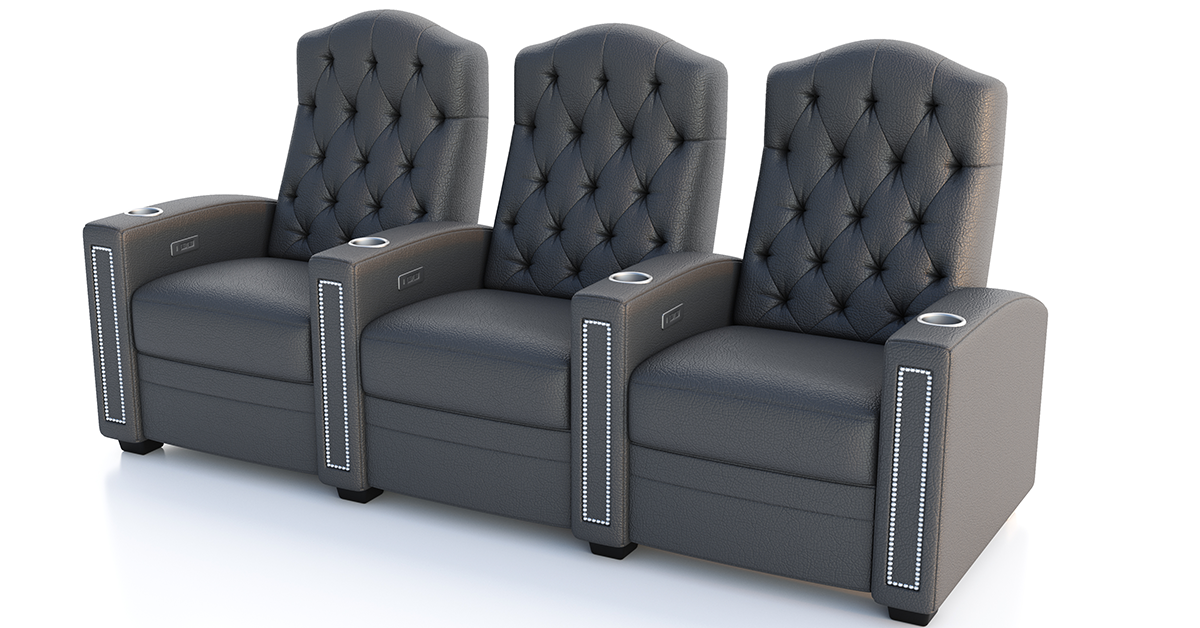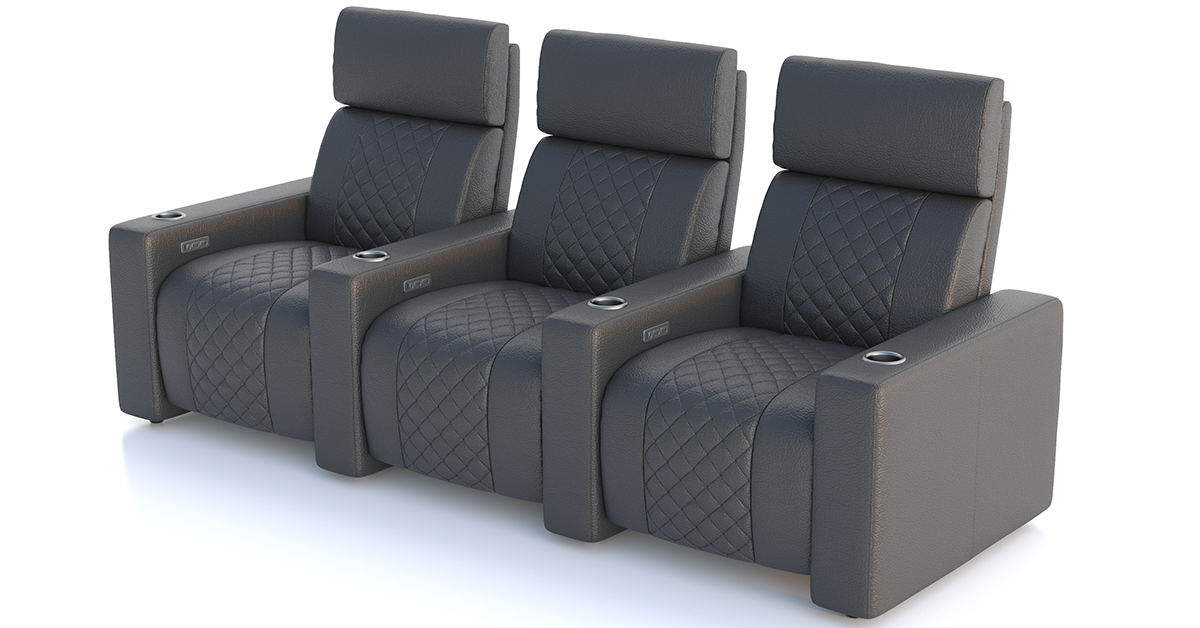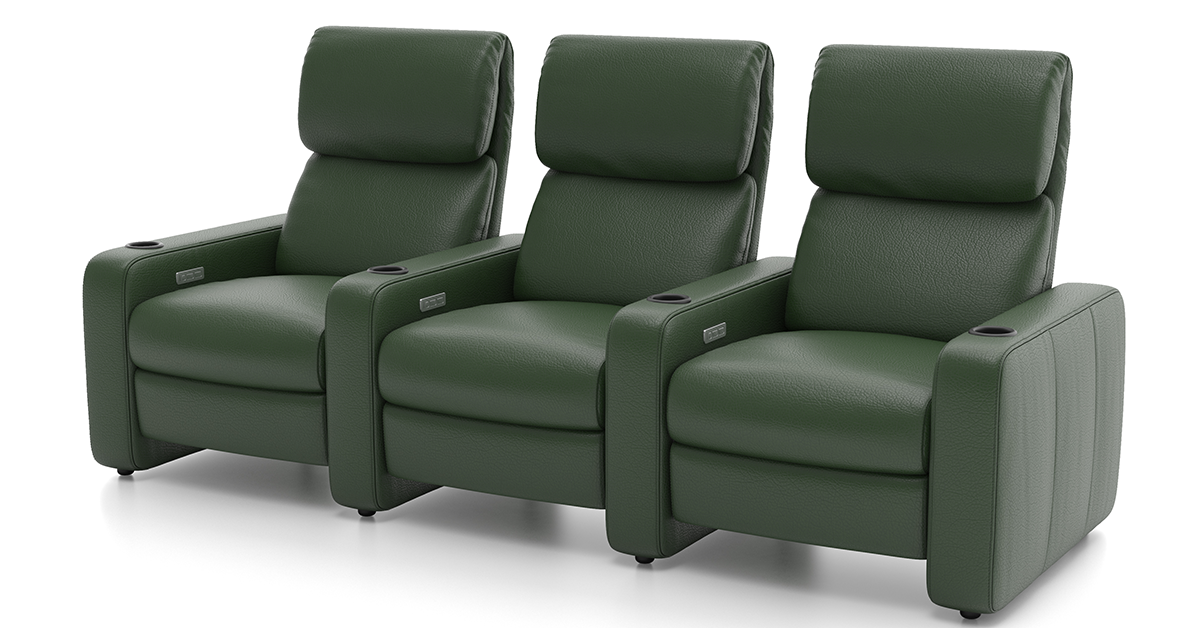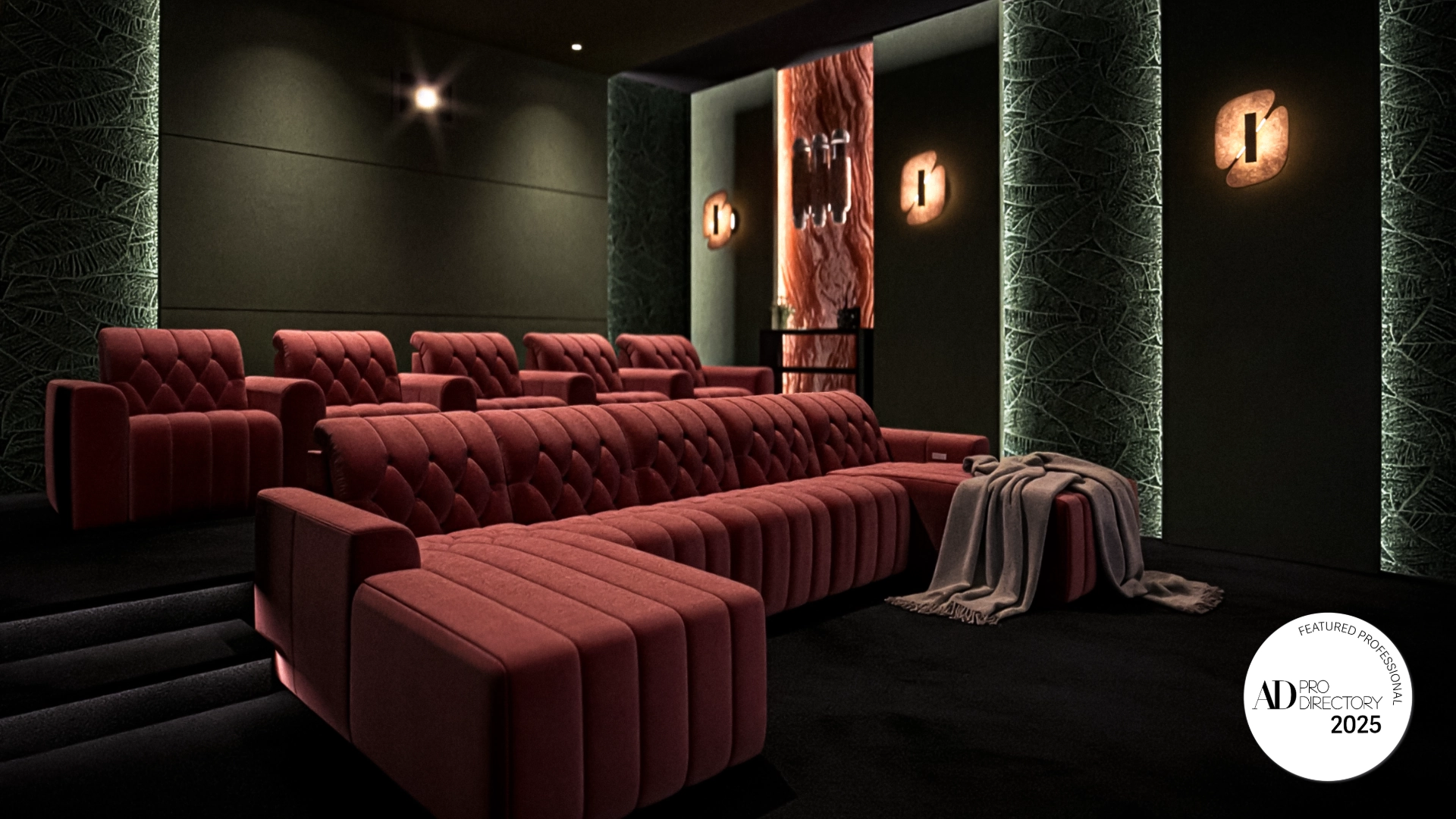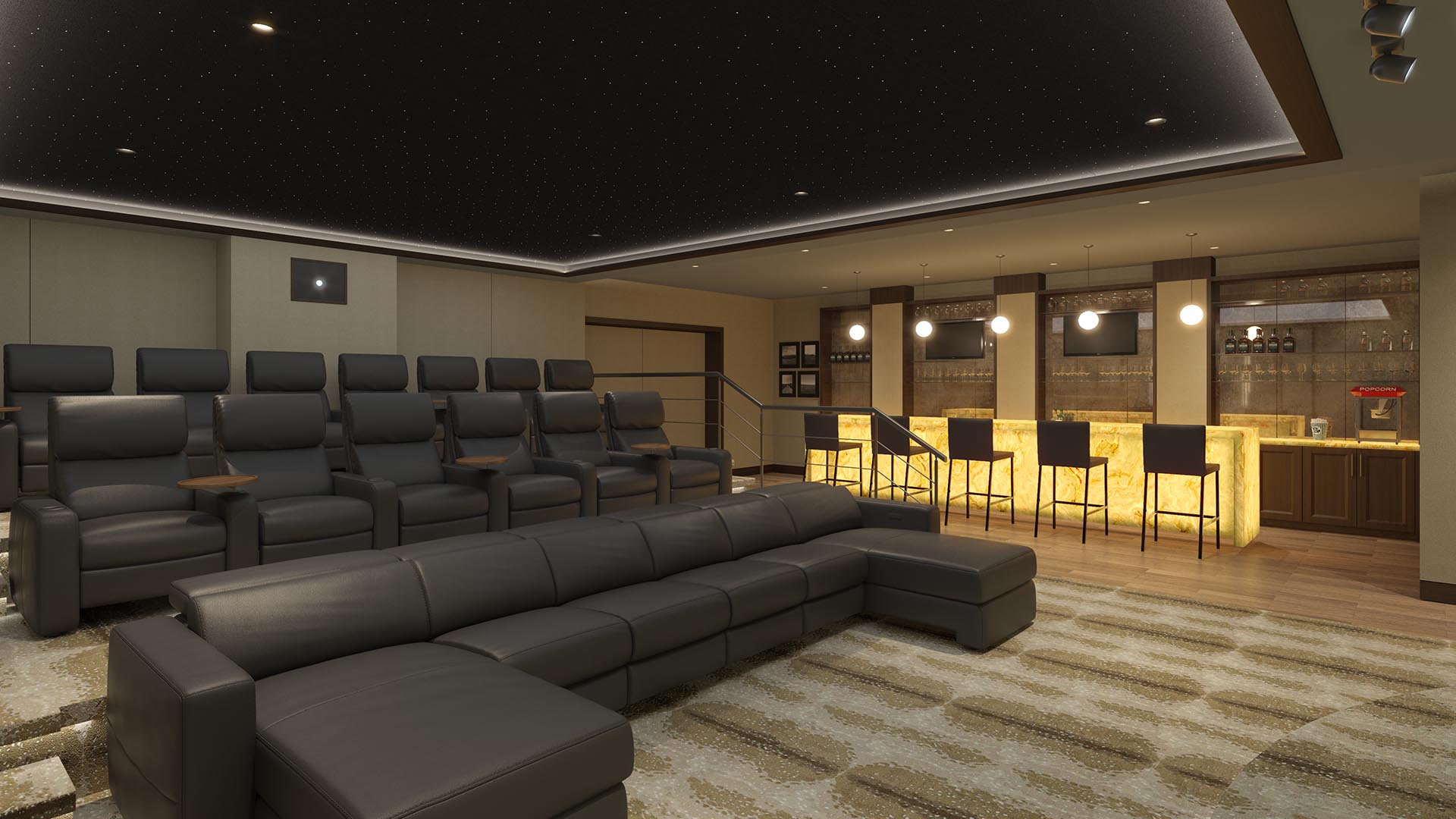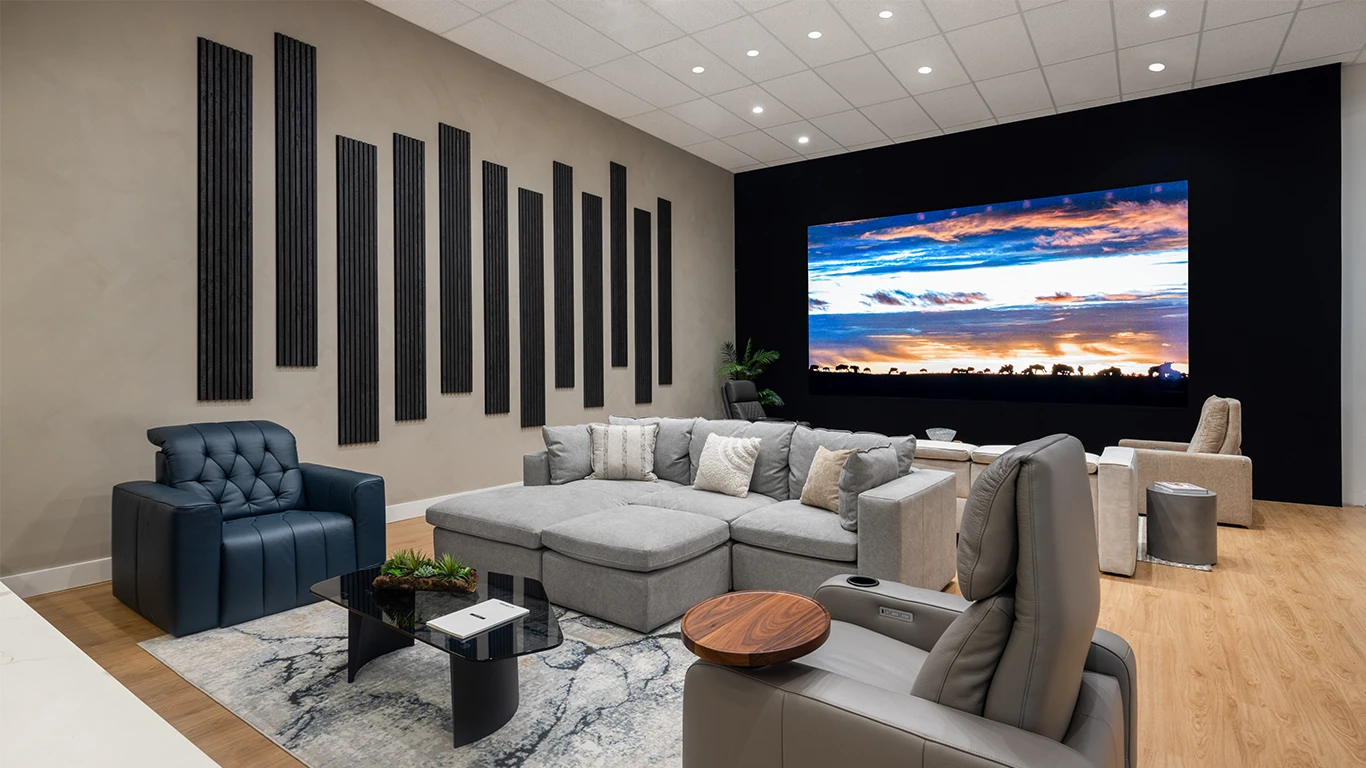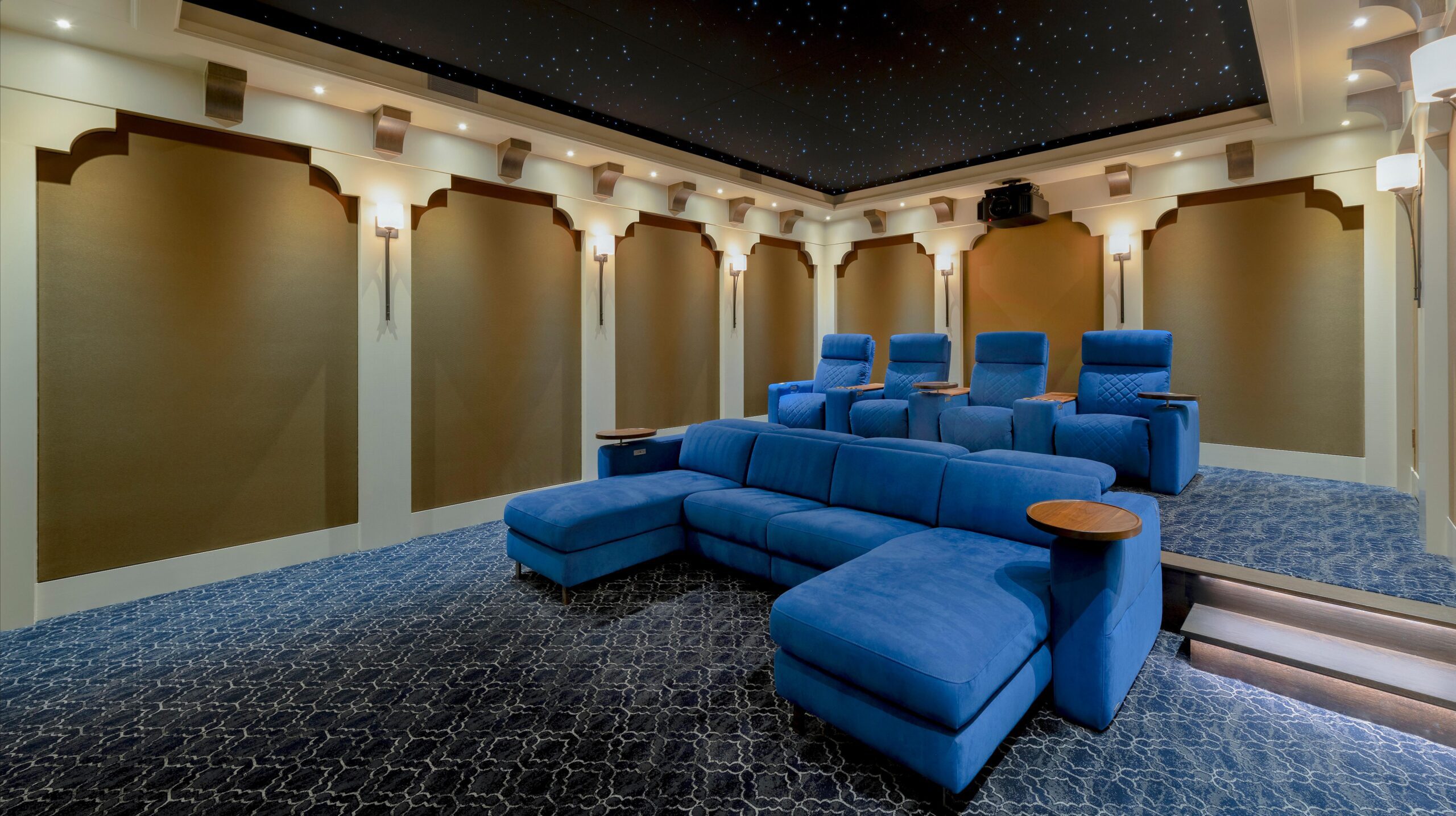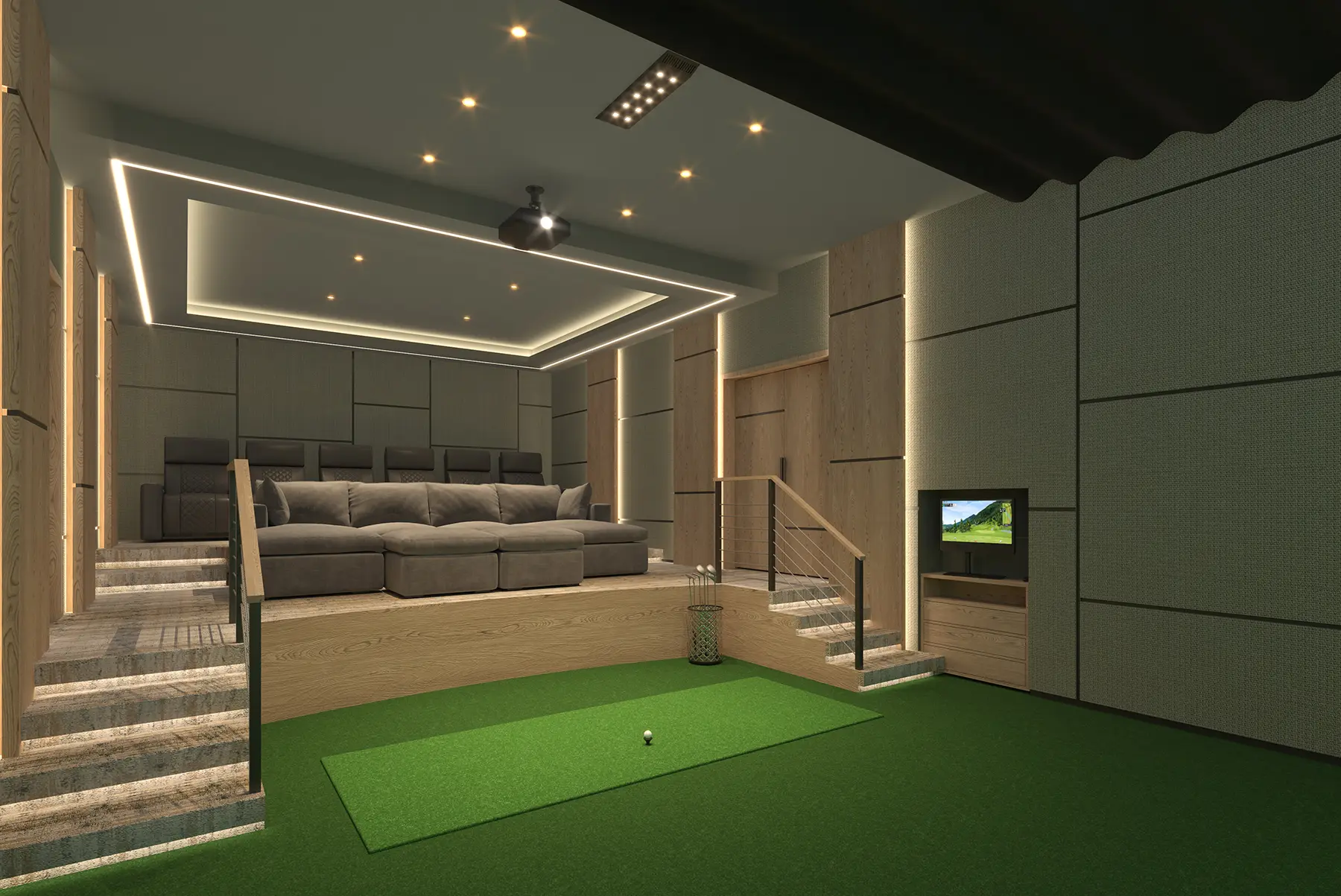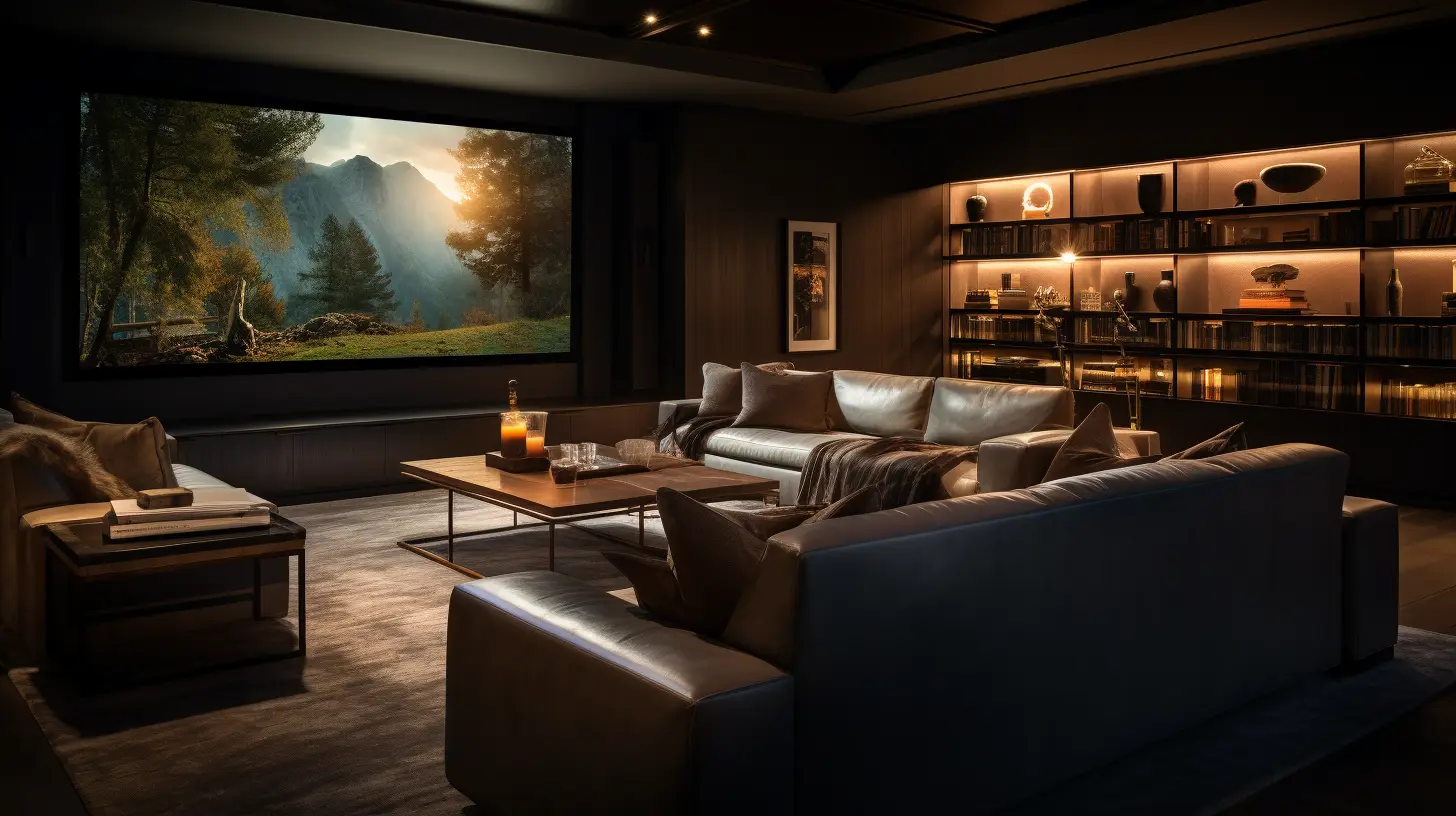INSIGHT BLOG
2025 Luxury Home Theater Design Trends for Interior Designers
Discover the top luxury home theater design trends for 2025, from warm neutrals and hidden acoustics to fiber optic ceilings and custom seating, and learn how CinemaTech helps creative teams deliver immersive, high-performance spaces with seamless aesthetic integration.
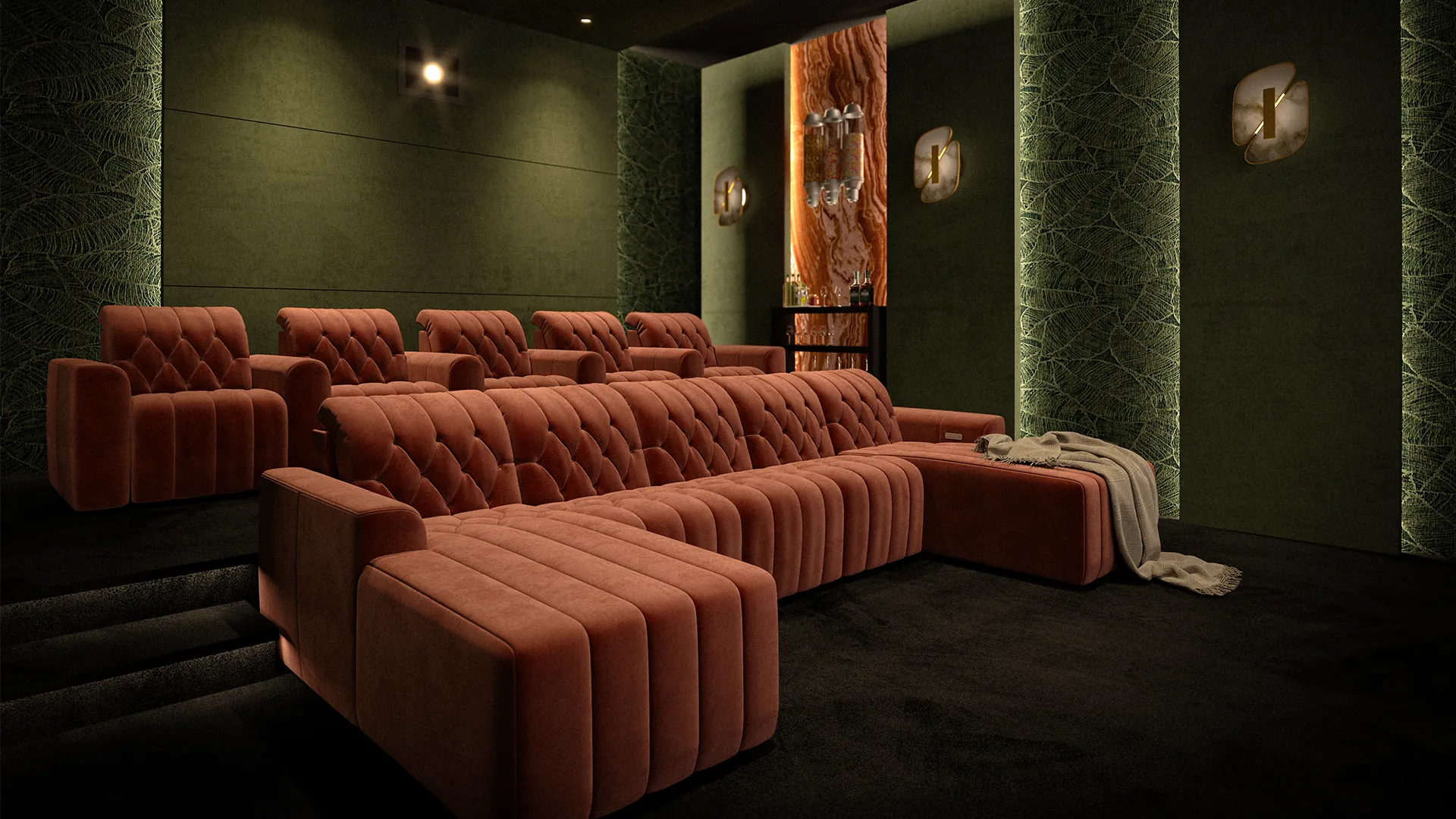
Above: Render of Theater 1124, featuring the Bordeaux Seats.
SECTIONS
The Designer’s Shortcut to a Flawless Luxury Home Cinema.
In 2025, luxury home theaters are no longer defined by tech alone, they’re expressions of artistry. Today’s most compelling cinema spaces blend architectural proportion, rich materiality, and immersive AV systems to create environments that feel intentional, elevated, and deeply personal.
These rooms aren’t just dark, dense spaces tucked away in a home, they’re design statements. They reflect the homeowner’s style, integrate seamlessly with the architecture, and deliver an unparalleled performance. As expectations rise, so does the complexity of balancing beauty with technical precision.
CinemaTech partners with creative leads to bring these visions to life, handling everything from acoustics and ergonomic seating to lighting control and sightline modeling. The result is a theater that performs flawlessly and feels effortlessly designed.
To explore how this evolution is shaping luxury home cinema, we spoke with Stacey Chu, Director of Theater Design at CinemaTech. Her insights throughout this article reveal the trends, strategies, and acoustic solutions redefining what’s possible in 2025.
“Luxury clients don’t just want a theater anymore; they want an immersive experience that feels intentional and beautifully designed,” says Stacey.
Materiality in 2025: Warm Browns, Taupes, and Textural Neutrals
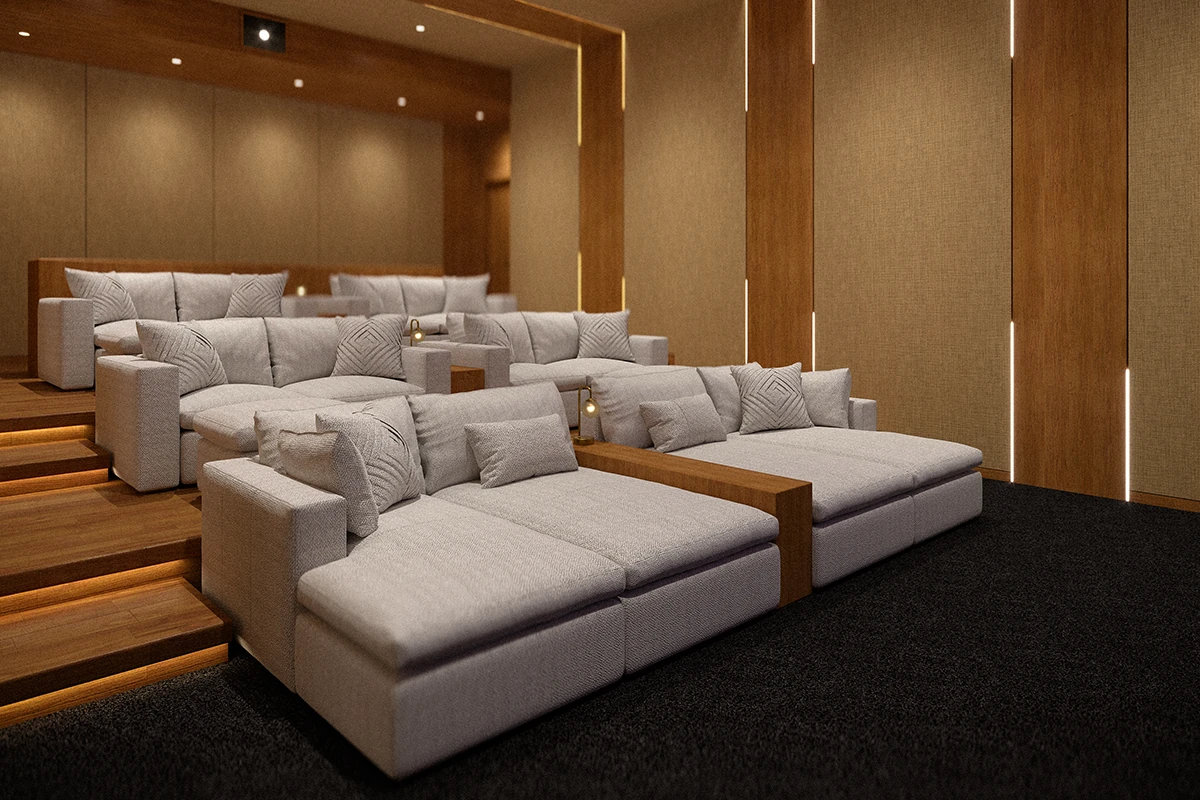
Above: Theater 7071, featuring the Huson sofa in a row of three.
Warm browns, taupes, and textured neutrals are replacing cooler grays in many luxury theater designs, but it’s not just about color trends. When paired with acoustically tested fabrics & treatments, these tones help maintain sound clarity while giving designers the freedom to create spaces that feel personal, refined, and anything but generic.
The modern home theater has shifted from cool minimalism to organic warmth. Stacey notes that designers are moving away from industrial grays toward layered neutral palettes that feel rich, grounded, and inviting.
“We’re seeing softer, more livable environments,” Stacey explains. “Clients want timeless tones that feel comfortable but still exude sophistication. Browns and taupes are replacing grays because they create a softer, more inviting atmosphere while maintaining a modern, luxurious feel.”
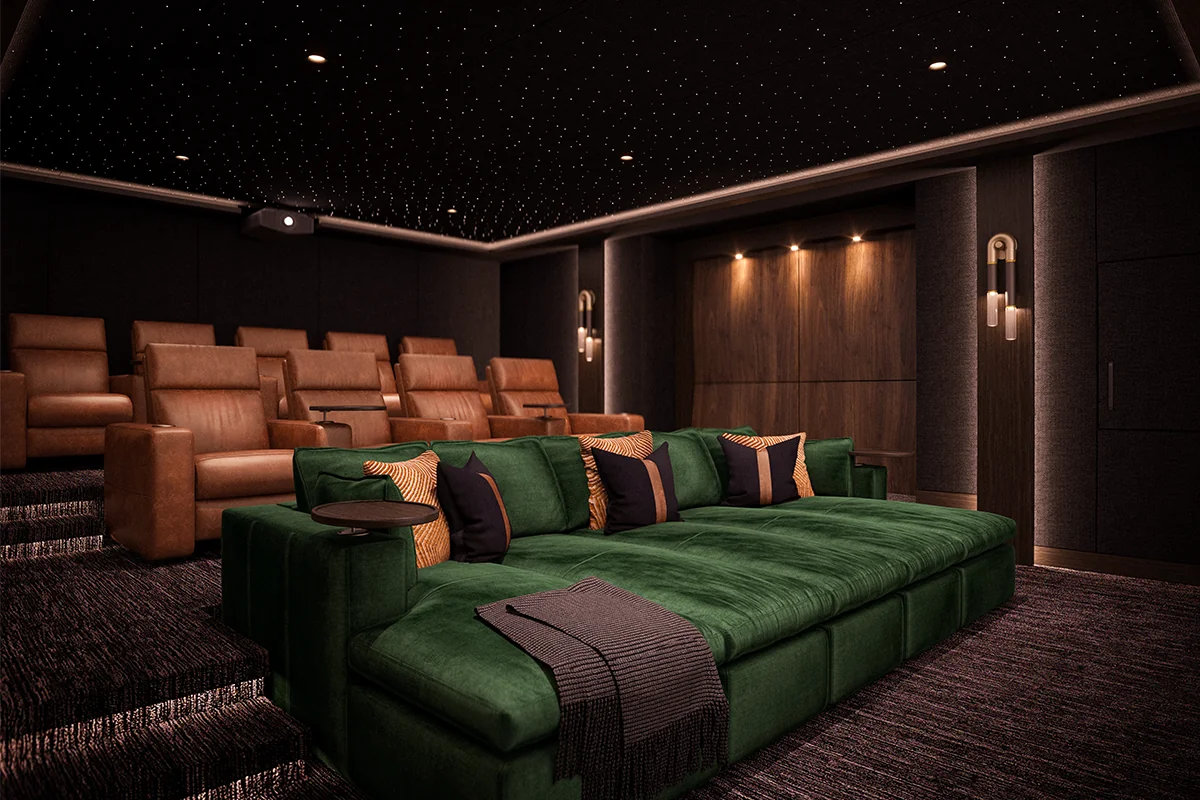
Above: Render of Theater 8036. Featuring the Hudson in the front row, and the Estrella High Back in the back two rows.
CinemaTech helps designers achieve this balance through thoughtful material curation. Using Alcantara suede, Elmo leather, and custom acoustically tested fabrics, the room’s materiality enhances texture and proportion without affecting performance.
It’s not about making every detail perform acoustically, it’s about finding the perfect balance. In today’s luxury theaters, designers aren’t just choosing materials for technical specs; they’re curating a palette that feels intentional and personal. While elements like wall fabrics are acoustically considered, other details, like piping or stitching, are chosen to elevate the aesthetic. The result is a space that sounds incredible, looks beautiful, and feels uniquely tailored to the homeowner.
Indirect LED Architecture: Lines, Coves, and Floating Planes
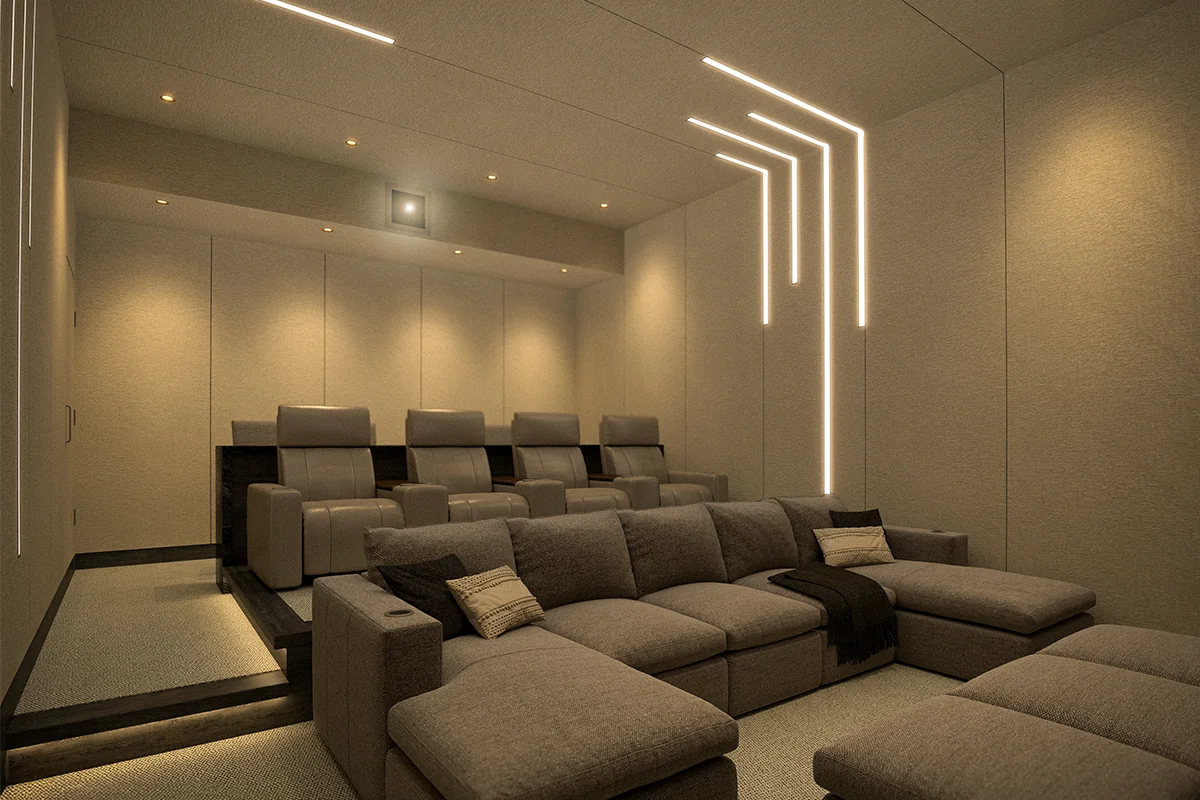
Above: Theater 6001 features linear lighting. For seating, it is furnished with the Hudson in the front row and the Sevilla without cross stitching in the back.
In today’s luxury home theaters, lighting isn’t just functional, it’s architectural. Indirect LED strips and fiber optic ceilings are defining the visual language of 2025, transforming cinema rooms into immersive, design-forward environments.
Rather than relying on traditional fixtures, creative teams are embedding linear LEDs into wall panels, risers, and soffits to create the illusion of floating planes. The result is a space that feels layered, atmospheric, and intentionally sculpted.
“Lighting is an art form,” says Stacey. “We’re seeing more use of concealed LEDs in ceilings, walls, and seating platforms to create futuristic effects that feel both elegant and immersive. And yes, it all has to work acoustically too.”
For transitional designs, fiber optic ceilings offer a dramatic yet soft glow. Spanning wall to wall, they can be customized with constellations, shooting stars, or subtle gradients, often paired with perimeter dimmable LEDs to create a fully immersive experience.
LIGHTING LANGUAGE: KEY TERMS THAT SHAPE THE ATMOSPHERE
LINEAR LIGHTING
Slim LED strips embedded into architectural elements like risers, wall panels, or ceiling coves. These create clean lines of illumination that guide the eye and add depth without visual clutter. Linear lighting is often used to define floating planes or accentuate seating platforms.
FIBER OPTIC CEILINGS
Ambient Glow
Soft, diffused lighting that sets the mood without drawing attention to itself. Often achieved through perimeter LEDs, step lighting, or concealed strips, ambient glow is essential for creating a relaxed, cinematic atmosphere that complements projection and acoustics.
Soffit & Cove Lighting
FLOATING PLANES
A visual effect created by concealing lighting beneath architectural surfaces—like seating platforms or ceiling panels—so they appear to “float.” This technique adds drama and sophistication while subtly guiding the viewer’s attention.
PERIMETER LIGHTING
LED strips or recessed fixtures placed around the edges of the room or ceiling. Perimeter lighting helps define the space, adds ambient glow, and can be programmed into lighting scenes for different viewing modes.
Fabric Wrapped Acoustics AND Hidden Loudspeakers
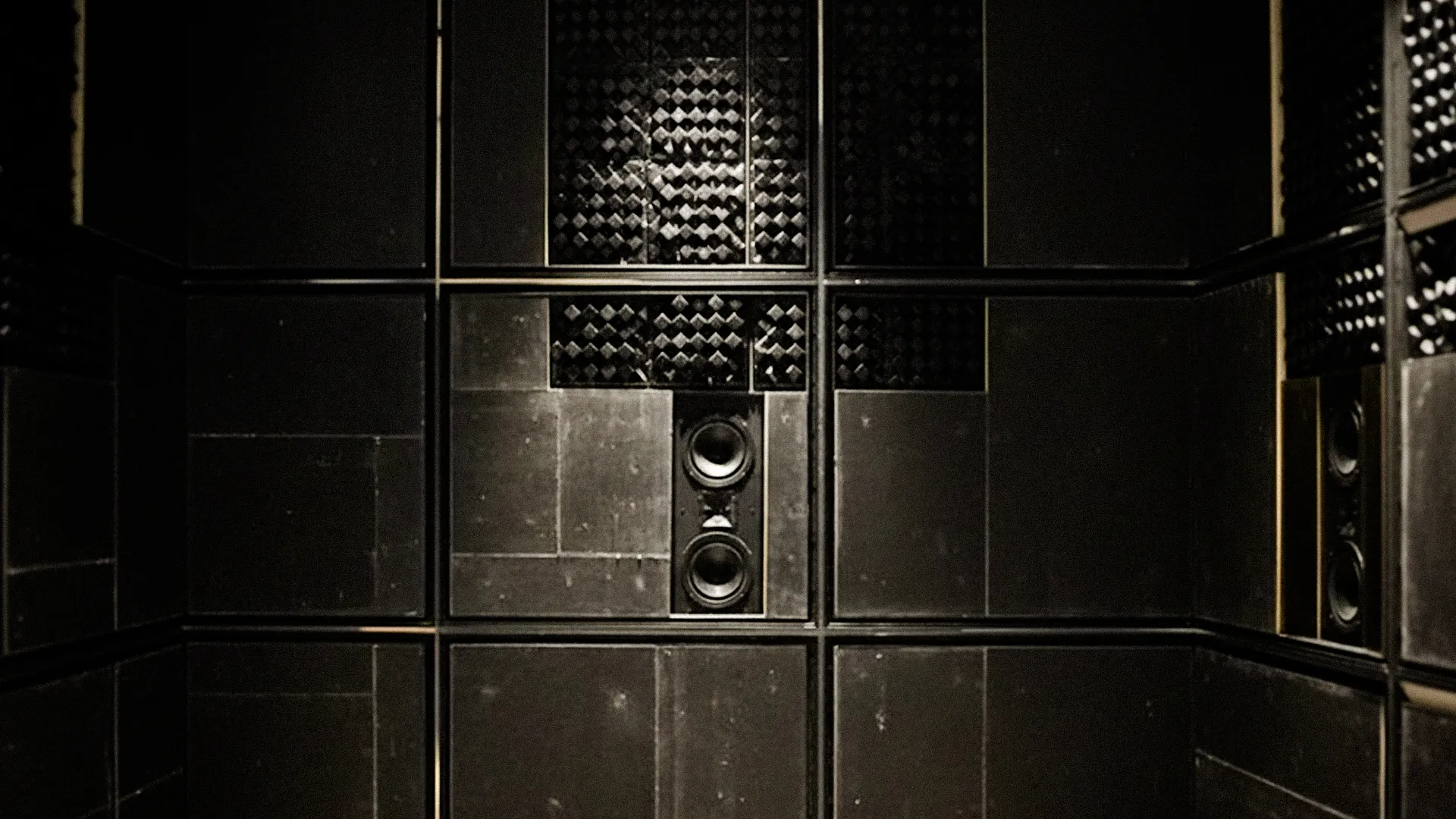
Above: CinemaTech’s Acoustic Room System, before fabric install. The fabric retainer system, acoustic panels and diffusers, are cut and installed onsite for precise placement.
In luxury home theaters, clients increasingly expect immersive sound without visible equipment. This has led to a growing emphasis on integrating speaker systems and acoustic treatments into the architectural fabric of the room. One effective approach involves concealing these elements behind acoustically transparent materials, allowing sound to pass through while maintaining a clean, uninterrupted visual aesthetic.
“Most clients don’t want to see any equipment in the room, especially the projector,” says Stacey Chu, Director of Theater Design at CinemaTech. “It can be an eyesore, generate heat, and be noisy. Concealing everything behind acoustically transparent fabrics helps the room feel seamless and sound incredible.”
She adds, “Wall fabrics must be acoustically transparent to avoid muffling the speakers. We often work with design teams to select materials that support both the aesthetic and the performance of the space.”

Above: A detailed illustration that breaks down the components of the Acoustic Room System.
To support this kind of integration, CinemaTech’s Acoustic Room System (ARS) is designed to blend into the architecture while preserving sound quality. The system is built on site, allowing it to be custom-made for each space. Our innovative fabric retainer system enables the use of acoustically tested fabrics in virtually any scenario, ensuring the room’s visual integrity is maintained without compromising performance. When applied thoughtfully, ARS allows the theater to feel cohesive, intentional, and acoustically refined.
Video Wall vs. Projection: Sightlines, Luminance, and Aesthetic Impact
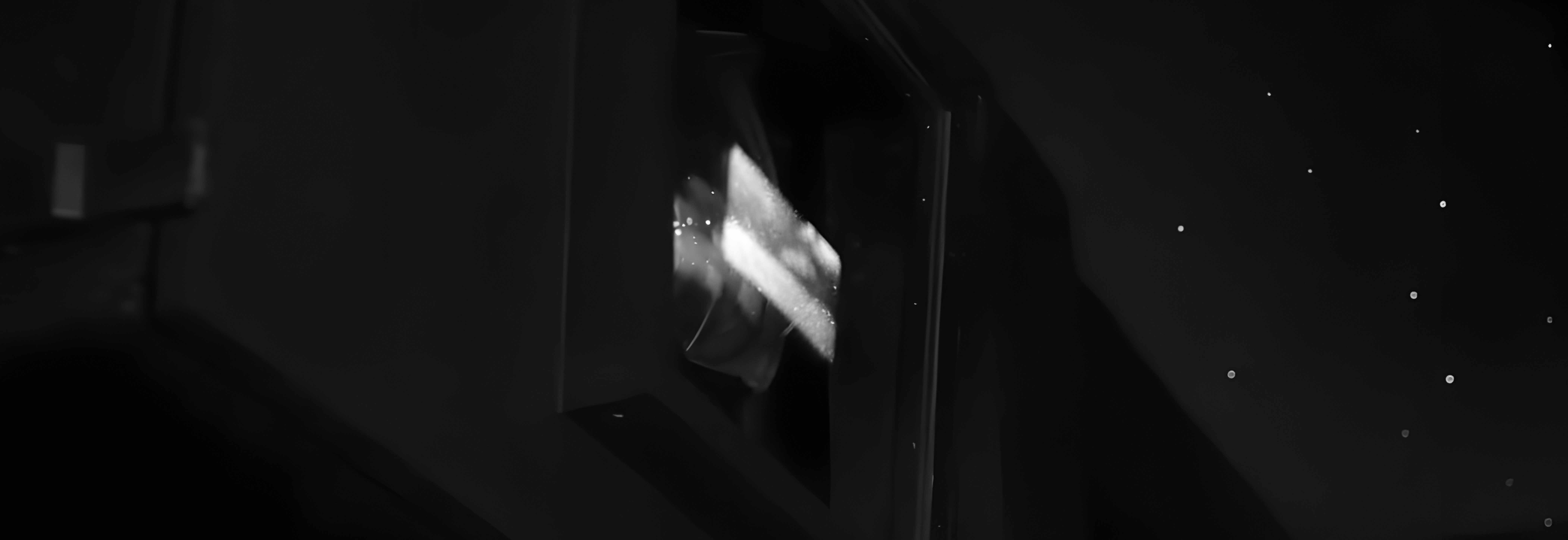
Above: Black and white photo of a projector within a Hushbox.
As home theaters evolve into multi-use spaces, the choice between projection systems and video walls has become more nuanced. While traditional projection still delivers unmatched cinematic texture, LED panels offer high brightness and versatility, especially in rooms designed for both movie nights and everyday media use.
“We still see projectors and screens in many projects,” says Chu, “but more clients are opting for video walls when they want a contemporary aesthetic and everyday usability. It’s all about maximizing screen size and speaker packages to deliver top-quality sound and an immersive experience.”
Each option brings its own set of design and performance considerations. Projection systems require careful planning around throw distance, ambient light, and screen placement, while video walls demand attention to luminance, viewing angles, and integration with architectural elements.
CinemaTech’s design team helps navigate these decisions early in the process, modeling sightlines, seating proportions, and acoustic impact to ensure the final result feels intentional and performs flawlessly. Whether the goal is the romance of projection or the precision of a digital wall, the key is aligning technology with the way the space will be used.
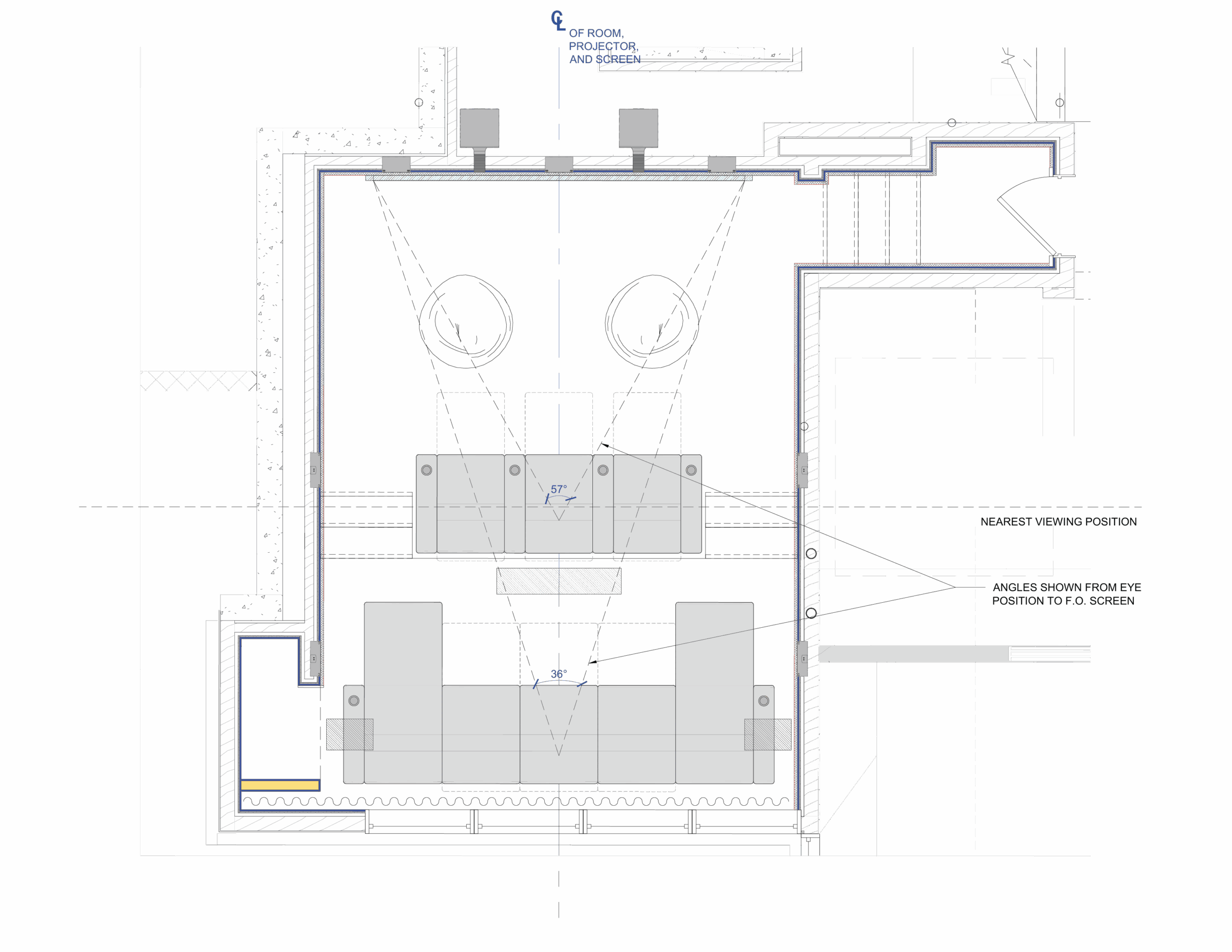
Above: AutoCAD drawing showing sitelines of a home theater. CinemaTech uses these to help plan precise plaement of the seats.
CinemaTech’s design team helps navigate these decisions early in the process, modeling sightlines, seating proportions, and acoustic impact to ensure the final result feels intentional and performs flawlessly. Whether the goal is the romance of projection or the precision of a digital wall, the key is aligning technology with the way the space will be used.
Avoiding Change Orders: Engage Acoustics and AV Early
In luxury home theater design, timing is everything. When acoustic and AV planning is delayed until after interiors are finalized, even the most stunning concepts can face costly compromises. Misplaced speakers, incompatible fabrics, and overlooked projector venting don’t just affect performance, they can disrupt the entire sensory experience.
For those shaping the vision of a high-end residential space, understanding how architecture influences acoustics is essential. Room shape, for example, plays a critical role. Rectangular layouts tend to support more predictable sound behavior, while square or irregular rooms often introduce acoustic challenges that require more intensive treatment.
Seating placement is another key factor. It’s not just about comfort or symmetry, it’s about acoustical geometry and sightlines. Ideal viewing requires precise calculations to ensure every seat aligns with the screen’s focal point and avoids audio dead zones. Without early coordination, even small layout decisions can lead to performance gaps that are difficult to correct later.
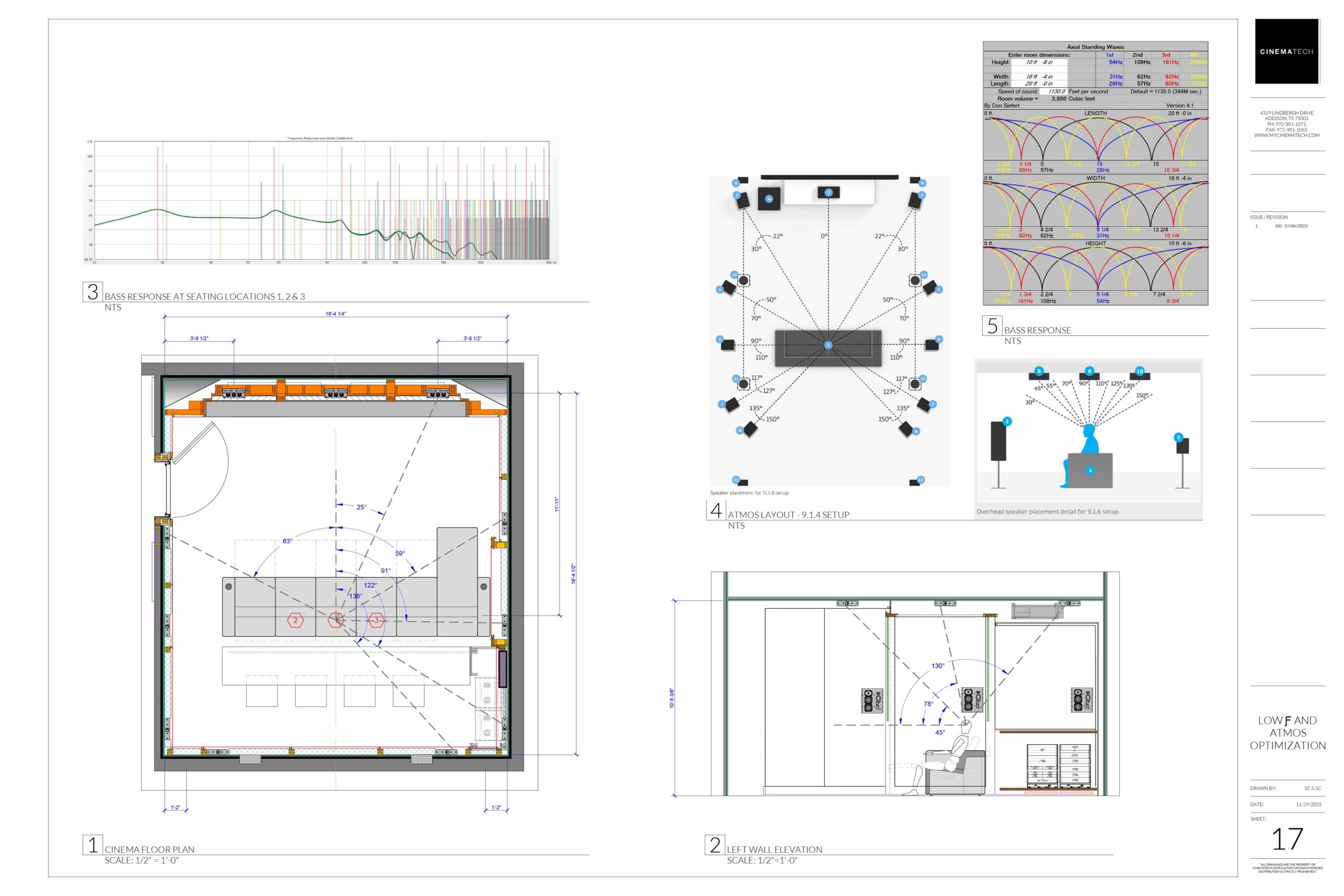
“Acoustics and AV aren’t just engineering challenges,” says Stacey Chu, Director of Theater Design at CinemaTech. “They’re part of the design language. When we’re involved early, we help ensure the space performs without disturbing the aesthetic.”
CinemaTech’s Design Service Program (DSP) supports creative teams from concept through completion, refining speaker elevations, coordinating HVAC placement, modeling sightlines, and aligning lighting layouts with projection needs. The result is a seamless integration of technology that enhances the space rather than competes with it.
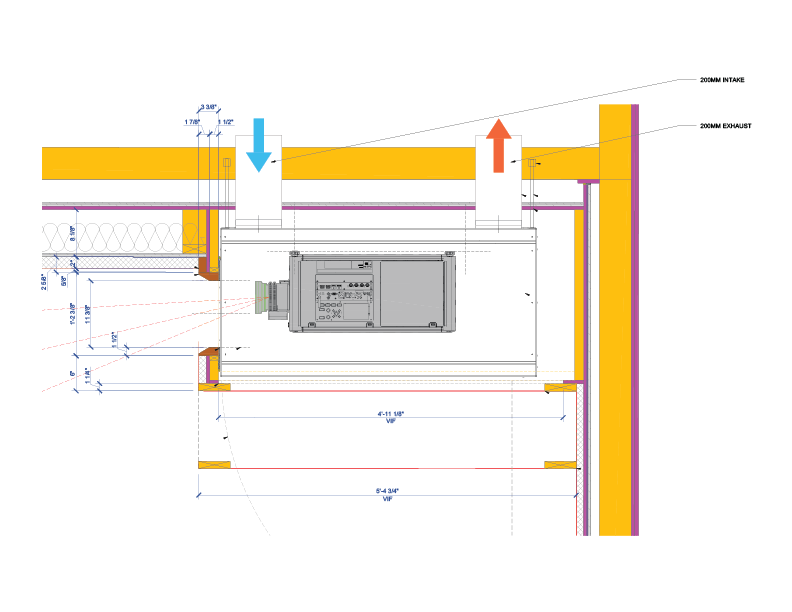
Above: A hushbox for a projector needs proper airflow, often necessitating HVAC supply and return vents. This setup is key to isolating the projector’s sound, giving an amazing viewing experience.
For those leading the vision, the takeaway is clear: early collaboration protects the design intent and ensures the final result is as flawless as it is functional.
Your Trusted Partner: Turnkey Expertise and Seamless Aesthetic Integration

In luxury home theater design, creative control is everything. The most successful projects are those where aesthetic vision and technical precision move in lockstep, where every acoustic panel, lighting detail, and seating element feels intentional, not added on.
CinemaTech functions as an extension of the design process, supporting the creative lead from early concept through final installation. Our Design Service Program (DSP) is built around collaboration, not complication. From initial consultation and AutoCAD layouts to 3D renderings and construction documentation, every detail is engineered to disappear into the architecture, enhancing the space without competing with it.
Above: The stunning transformation in our Florida Showroom Theater with a striking before and after image. CinemaTech’s 3D renderings providing a nearly photorealistic preview before construction begins.
“We guide the team from concept to completion,” says Stacey Chu, Director of Theater Design at CinemaTech. “Our goal is to make sure the room performs flawlessly while preserving the integrity of the design.”
Whether it’s acoustic modeling, seating proportioning, or projector concealment, CinemaTech handles the technical complexity so the creative team can stay focused on the vision. The result is a theater that looks effortless, performs beautifully, and feels entirely bespoke.
Designer FAQ: Integrated Home Cinema Basics
Luxury home theater design in 2025 is about balance, technical precision hidden within beautiful simplicity. As lighting, sound, and comfort continue to converge, success depends on partnerships that merge creativity with engineering.
The most memorable theaters aren’t just well-equipped, they’re well-considered. Every acoustic detail, lighting layer, and seating element should feel intentional, not added on. That kind of cohesion doesn’t happen by accident; it happens through early collaboration.
“When we work together early, the results are extraordinary,” says Stacey. “Designers can focus on beauty, we’ll handle the science behind it.”
Whether you’re shaping a bold architectural statement or a quiet retreat, CinemaTech helps ensure the final space performs as flawlessly as it looks.
